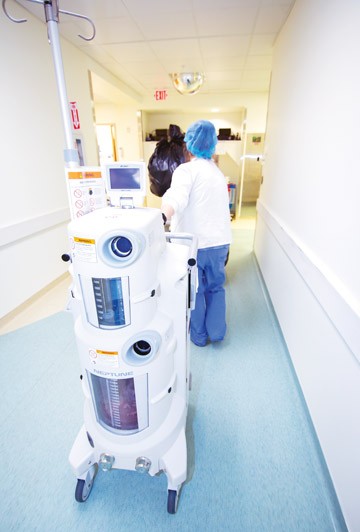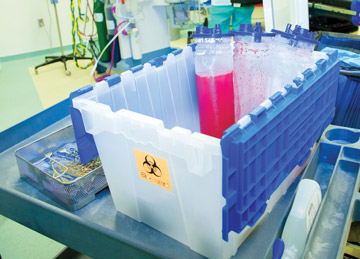Last month, surgeons performed 28 fluid-spewing orthopedic cases in a single day at the 3-OR Boston Out-Patient Surgical Suites in Waltham, Mass. Had that many procedures been performed when the facility opened in 2004, fluid waste management would have been an aggravating and messy part of the day. Nurses would have been lugging dozens of heavy, fluid-filled canisters out of the ORs, and would have been exposed to splashback when they poured the contaminated contents down the hopper. Surgeons wouldn't have liked all the time it took nurses to manually dispose of the fluid waste, and the surgical team would have had to shuffle along on slick OR floors so they didn't slip and fall.
None of that happened on that recent July day because the surgery center had decided years ago to invest in a closed fluid waste management system.
"I didn't think about fluid management at all," says Greg DeConciliis, PA-C, CASC, administrator at Boston Out-Patient Surgical Suites. "We didn't have any issues."
In that way, good fluid waste management systems are like refs at a well-officiated basketball game: When they're doing their job, you barely notice that they're there. There are 2 main options of closed collection systems, and the right choice for your facility depends on your budget and case mix (see "Time for a Fluid Waste Management Upgrade?").
- Wall-mounted removal. Fluid- collection canisters are positioned next to the OR table on a mobile cart. When the canisters are filled, nurses or surgical techs roll the unit to a wall-mounted disposal system, remove the filled canisters and place them in the system, which automatically flush the canisters.
- Mobile collection. These mobile units have large internal reservoirs with the capacity to collect runoff during several fluid-heavy cases. Staff wheel a cart into the OR and attach its ports to arthroscopy pumps, surgical drapes or floor wicking devices. When the cart's reservoirs are filled, staff roll the cart to a dedicated docking station, which automatically empties the cart's contents into the sewer system.
"We decided to invest in a mobile closed system after realizing that the disposal costs, storage issues, staff complaints and potential for employee injury all meant that buying a closed system was worth the expense," says Mr. DeConciliis.
.svg?sfvrsn=be606e78_3)


.svg?sfvrsn=56b2f850_5)